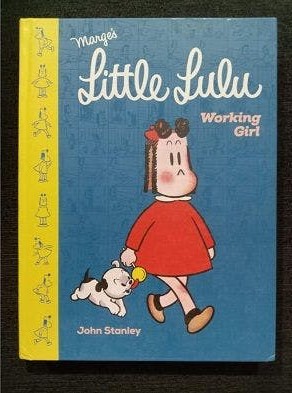The author was quite an ‘MCP’ as a seven-year-old, looking down upon comic books featuring girls as main characters, until Little Lulu came along.
Wonder Woman — pah!
An avid reader of comics since the age of seven, my favourite characters were always male; The Phantom, Batman, Superman, Flash Gordon, Tarzan of the Apes, The Lone Ranger, Bugs Bunny and more. No self-respecting seven-year-old boy would ever admit to liking female comic characters. Wonder Woman — pah! Supergirl — pshaw! Only sissies would ever want to read about such characters. I had heard of and been outraged by the adage that little girls were made of ‘sugar and spice and everything nice ‘ while little boys were made of ‘frogs and snails and puppy dogs tails.’ I firmly believed that it was exactly the opposite. As a comic book aficionado, I barely tolerated Diana Palmer, later Diana Walker, Princess Narda, Jane Porter, Dale Arden, Lois Lane and others of their ilk, and did so only because they were the chosen female companions of the Phantom, Mandrake the Magician, Tarzan of the Apes, Flash Gordon and Superman respectively. Why these wonderful manly heroes bothered with them was beyond my comprehension. All these lachrymose ladies were good for was doing something stupid and getting into situations that their long-suffering better halves would have to extricate them from, time which could have been better spent saving the world from the many threats that they had to face on a daily basis. Of course, as someone who would read anything with illustrated panels and speech bubbles, when faced with the situation of having nothing else to read, I reluctantly stooped to the level of reading some comics with ( yuck ) female main characters. These included Dell Comics’ Little Iodine and Daisy Duck, Gold Key Comics’ The Girl From UNCLE, Jet Dream, Pauline Peril and Tiger Girl among others and the Harvey Comics girls, Little Lotta, Little Dot, Playful Little Audrey and Wendy The Good Little Witch.

Secret Fan of Little Lulu
There was one character however that I was secretly a fan of, though I’d never let anybody know about this and would not reveal it to the world even under the threat of torture. This was a homely little girl with frizzy black hair tied in pigtails called Little Lulu. Originally published by Dell comics and then by Gold Key Comics, the title was one of their consistently biggest sellers. I read my first Little Lulu comic at age seven when my father bought one of these for me, along with four or five other Gold Key titles, from the A.H Wheeler stall at Mathura Railway Station. I wasn’t too pleased with it and ignored it as I plunged into other comics which included a Tarzan issue and a Turok Son of Stone along with a couple of Disney Comics.
Once I was done with these I was forced to pick up Little Lulu. I fully expected it to be a typically namby-pamby little girl-oriented comic but found something quite different. I took an instant dislike to the little smart aleck who, horror of horrors, was always trying to outsmart the boys, an angelic bunch including Tubby, Iggy and Wilbur (well maybe not so angelic but one has to stand by one’s sex). Not only did Little Lulu go up against the Boys who had a Clubhouse with the perfectly reasonable board outside that said ‘ No Girls Allowed’, she even got the better of them on most occasions. Accompanied by her spiky-haired, buck-toothed friend Annie this monstrous female took the boys on and bested them. This was unheard of. I was sure that the comics were written by a girl.

Nobody else would think up such preposterous situations where the superior sex was regularly humiliated. All this even though Tubby was her best friend while also being her main antagonist. Despite all the conflicting emotions, I shamefully realised that I enjoyed it. The next time my father was due to go to the station I presented my usual demand for comics, adding sotto voce that I would also like any Little Lulu comic that was available. My father looked at me with raised eyebrows as if wondering why I had suddenly taken a liking to such a character, different from the mighty thewed he-men I usually idolised. I kept my face studiously blank and replied offhand that I liked the character of Tubby.
Little Lulu on Print
Little Lulu started life as a single panel cartoon in the Saturday Evening Post in 1935. She was created by Marjorie Henderson Buell ( pen name Marge). The single panel gags continued to be published weekly till 1944. She was primarily created as a female counterpart and successor to the hugely successful cartoon character Henry, created by Carl Anderson. Marge stopped drawing the character in 1947 but it was in 1950 that Little Lulu came into her own. She first appeared in 10 issues of Dell’s Four Color Comics with script and layouts by John Stanley and art primarily by Irving Tripp. With these series proving popular she got her own series with the title Marge’s Little Lulu. The series would continue in Dell and later Gold Key comics till 1984. The comics were translated into several languages. Unfortunately, she never appeared in any Indian languages.

John Stanley, the Genius
John Stanley was a multi-faceted comic genius who scripted the comics and also assisted with the art before the art-related chores were taken over by Charles Hedinger and then Irving Tripp. The Stanley / Tripp era was Little Lulu’s finest hour which continued until 1959. Stanley had a unique style of his own. His stories were consistently funny, often using bizarre, macabre and surreal situations to create humour. His stories were certainly different from the safe, bland stories being churned out for kids. They seemed to have a hidden subtext and the sardonic tone seemed to indicate that the writer wanted to convey a lot of things that he was not permitted to by the Comics Code Authority. He created most of the supporting characters in the strip including Tubby and Lulu’s neighbour Alvin, an annoying hyperactive little boy who Lulu tells stories involving a heroine, who suspiciously resembles Lulu herself up against wicked Witch Hazel and her niece Little Itch the Bad Little Witch. The two witches themselves would need a Freudian analysis to understand all the hidden implications. Tubby became popular enough to merit a spinoff series of his own. The John Stanley run on the title has been reprinted in its entirety first by Another Rainbow press and then by Dark Horse who reprinted the Stanley canon in 29 trade paperbacks and a further 4 trade paperbacks featuring his entire run on Tubby.
Stanley’s genius was not confined to Little Lulu. He scripted some terrific issues for Dell’s Raggedy Ann and Andy and Nancy and Sluggo and also created Melvin Monster ( a humorous comic about a little monster ), Thirteen Going on Eighteen ( a teen humour strip ), Around the Block with Dunc and Loo ( and other teen humour comics ) and my all-time favourite horror comic, a one-shot giant Dell comic from 1962 called Tales From The Tomb. He also created the character of O.G Whiz for Gold Key, a boy millionaire who owns his own toy company. In my book, Stanley belongs right up there in the pantheon of comicdom’s greats alongside Carl Barks, Will Eisner, Walt Kelly and Lee and Kirby.
Little Lulu is indeed one of the most iconic of kids comics ( also enjoying cult status among adults )and should be as revered as Peanuts, Calvin and Hobbes and Sugar and Spike. Unfortunately in a world that seems to be increasingly infatuated with superhero dreck churned out by hack writers and artists of questionable talent, the work of a true genius appears to have slipped through the cracks.

Fighter for gender equality
The one aspect of the legend of Little Lulu that appears to have been missed by historians of comic book culture is her status as one of the earliest icons of gender equality Before Gloria Steinem, Sylvia Plath, Germaine Greer, Women’s Lib and Burn the Bra, there was Little Lulu. In her understated, determined, forthright but at times devious way she took the battle to the enemy camp and proved that little girls ( or women) were every bit equal and in many ways superior to their male counterparts. She is the one female comic character I can think of who embodies and personifies the truth that there is no superior sex and that any such misconception exists only in the eye of the beholder. And she turned a seven-year-old MCP into an ardent believer. Discover her world and you’ll become one too.
Write to us at [email protected]




